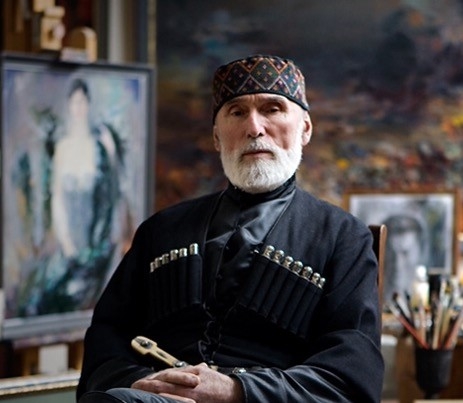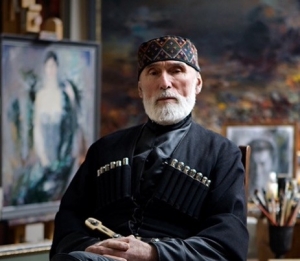Patashuri: Admiring Georgia with a Paintbrush in Hand
His paintings resemble their author: vivid, engaging, colorful, emotionally intense, and delicate at the same time. Talking to him feels like travelling around Georgia through his eyes, a journey that is filled with so much love and pure admiration for his country, the beauty of its nature, and its history, an admiration which is echoed in his paintings, a kaleidoscope of magnificent landscapes, battle scenes from Georgian history, and human portraits that will haunt you long after the moment you see them.
Together with BI Auction for Art, GEORGIA TODAY continues to feature famous Georgian painters. In this issue, we introduce Ilia Patashuri, a well-known Georgian artist, holder of an Order of Honor, named as People’s Artist of Georgia, and professor at the Tbilisi State Academy of Arts. His works are exhibited internationally in Greece, Germany, France, Denmark, Belgium, Finland, Yugoslavia, Poland, Japan, Russia, Azerbaijan, Armenia, and Baltic countries.
What influenced you to become a painter?
I was born in the village of Khevsha, Dusheti region, and it has the most beautiful nature. I think that was one of the factors that led to my becoming a painter. There are gravestones in my village with different paintings on them. Sometimes it might be a woman knitting, or a man with a horn dressed in chokha, or a sheep, and villagers colored these figures with oil paint, and it amazed and fascinated me. I often drew on stones with charcoal, and my mother told me I started drawing at the age of four or five—at that time I had no idea that paper, pencils or a paint brush existed! I tried to paint characters from the tales my father used to tell me, and that’s how I started. Another thing I do remember vividly is my encounter with a famous Georgian artist in my home village one day when I was returning home from school. I was in the second grade then. The painter was sitting and working, I came close and saw that he was drawing one of the female villagers. He looked at me as I approached and asked if I liked to draw. When I said yes, he asked me to show him my drawings. He looked through all of them and told me that I could become an artist if I continued to work hard. His words were very encouraging to me. He even asked me what my name was and liked that it was Ilia. But at that age I didn’t know he was referring to Ilia Chavchavadze. Years passed, it was 1948, and I came to study to Tbilisi, at the Nikoladze College of Art. Together with my fellow students, we went to an exhibition and I recognized the painting of a woman. I knew her very well since she was from my village. I remembered the painter drawing her. It was Lado Gudiashvili!
How would you characterize yourself as an artist?
I love drawing landscapes most, probably because I was born in a country like Georgia where the colors of every season are all so exquisitely different. When I used to travel to Gori in summer, I saw fields full of poppies: red, violet, pink, and it inspired me greatly. What surprises me is that often people aren’t even able to notice that beauty.
As an artist, I don’t think I should resemble others and for that a certain amount of firmness is needed. You have to be crazy in a way; you have to be the best, and you have to be professional. That’s why I admire Galaktion Tabidze and Vazha Pshavela. If you’re gifted with a talent, you should guard it, but something has to inspire you as an artist. I’ll be 80 next year and I still have so many things to do; it’s all in my heart, in my emotions. I remember that Pseudo-Longinus, a great philosopher, said that to create a true masterpiece, a chef d’oeuvre, an artist should have first a brave spirit—both Galaktion and Vazha Pshavela had it—and second, to be captivated with passion. If you have passion, he said, you can be amazed by the very nature of work that is born suddenly, sometimes even unexpectedly.
Where do you find inspiration for your work?
Inspiration may come from a sudden emotion: I may be disrupted from work and get angry, and mix the colors on the palette accordingly, but that is also a process of creation. Impression is very important, too. If you look at the clouds in the Tbilisi sky, they are totally different from the clouds in the mountains of Georgia. Those contrasts are amazing and I think an artist has to be just a little bit crazy, in a creative way, to capture all these differences. In a way, the process of work has its own secrets and mystery.
Is there anything you regret in your career?
I regret that for different reasons in different periods of my life, I didn’t have enough time to work more.
Who are the artists you admire and who defined you?
Vincent Van Gogh, Paul Cezanne, to a certain point everyone’s imitating, but it’s temporary—an artist should find his own voice. Yes, those great painters inspired and motivated me but then I started exploring my own land’s landscape. It’s important to find your own colors, your own style. Plagiarism is intolerable.
What would you advise the young?
It’s very difficult to advise. They should be passionate about what they do and stay true and devoted. If they’re given a talent to hold a paintbrush in their hands, then it’s for a reason.
Nino Gugunishvili











